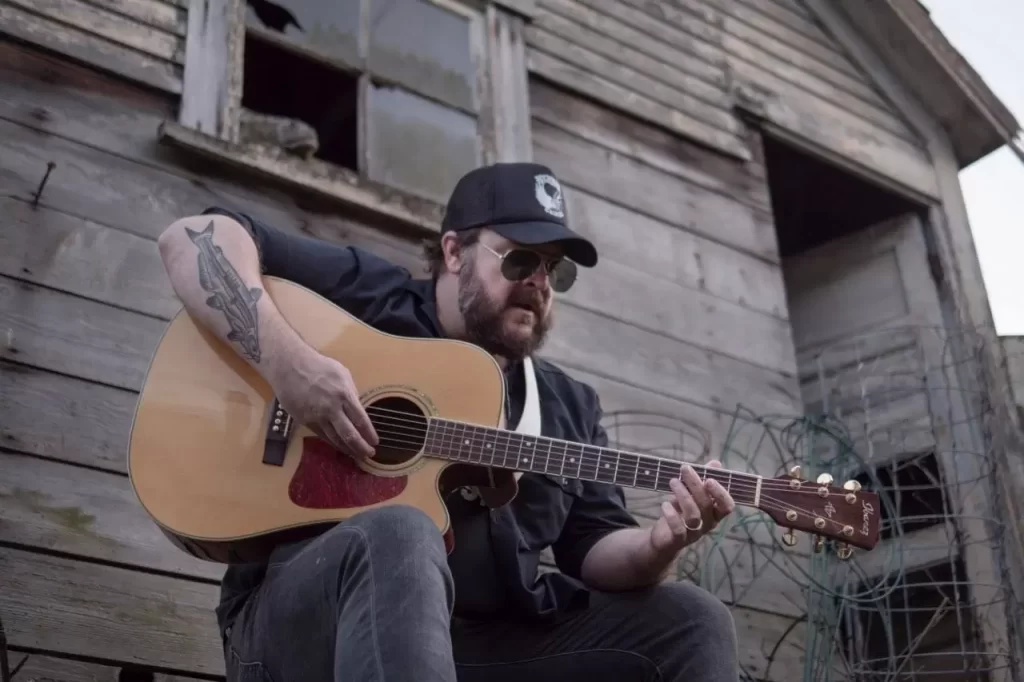Pandora Sessions, Robert Connely Farr’s latest effort, was inspired by his mentorship under elder statesmen of the blues in his home state of Mississippi. Jimmy “Duck” Holmes has been guiding Farr in the Bentonia Style of the Delta Blues, and he’s also learned directly from Mississippi Bluesmen RL Boyce and Terry Harmonica Bean.

The Bentonia style of Delta blues is always in an open C or D minor tuning, with the songs having less formal structure than what a 12-bar song might have. Due to the lack of a more formal structure, Farr tells me, “there is a drony-ness to the songs, kind of like a train chugging along down the track.”
Jimmy’s juke joint, Blue Front Café, just so happens to be on the railroad track connecting New Orleans to Chicago. “And you can’t play out there without the train coming through once during your set!”
From the heartbeat of Vancouver’s local scene to his personal reflections on legacy and loss, Pandora Sessions is as much about the music as it is about the moments that make it. Of the album, he explains, “We let the songs come to us as opposed to writing them (most of them) first, and we recorded those first takes. The cover image itself was taken down at my dad’s shop at home on the place – a gurney, a stool, and a rope. Lots of these songs are about hurting or dying or trains to nowhere. All in all there’s a darkness to this album that is very real in our lives.”
His drummer and musical co-conspirator on this album and for the past 15 years, Jay Bundy Johnson, directed the video for “Things They Tellin’ You.” Drawing from Farr’s dark, minimalist songwriting and Jay’s powerful visual style, their collaboration makes a strong statement about the universality of pain and the blurred lines between truth and deception in contemporary life. The song’s tone—melancholic yet urgent—creates space for reflection while conveying a sense of resignation to an overwhelming world.
The incorporation of the Prelinger Archive’s found footage emphasizes that the innocence of youth is no shield against the harsh realities that persist through history. The footage, from the Ivan Besse Collection (1938-39), was shot by an amateur filmmaker and photographer from Britton, South Dakota, who ran the Strand Movie Theatre and would show his films of locals before the main feature. Besse died in Britton on September 2, 2005, at the age of 98. (For further context: Rick Prelinger talk about Besse’s work and the history (and importance of) home movies.)
As a visual artist I have based most of my output on the practice of making use of the “found object” either through collage or assemblage techniques. This approach lends itself well to the material available through the Prelinger Archive. In creating the videos for The Pandora Sessions, it was my intention to create a visual complement to the powerful simplicity and dark themes found in Robert Connely Farr’s writing.
Jay Bundy Johnson
The most powerful aspect of these videos that Jay’s made with this old footage is the sense that suffering seems irrelevant to time – it’s a constant. This song, combined with the footage of these children is more of a lament, or a mourning. We get hit with so much these days. It’s hard to distinguish the true from the false. I’m just asking people to pay attention to the ‘Things They Tellin You.’ And like my Daddy said right before he died, to ‘move forward with love; love is the only way forward.’
Robert Connely Farr
Farr recorded the album at a private studio on Pandora Street in East Vancouver, where he has lived for nearly two decades. Reflecting on the local music scene, he shares, “When I first moved here, I’d head to the Railway Club downtown to see legends like Herald Nix, Mac Pontiac, and Rich Hope. The alt-country scene was thriving when I arrived, although it has since faded, giving way to newer acts like Orville Peck. Vancouver has a rich musical history with bands like DOA and a long tradition of great artists coming to record here. The city’s soundscape is dotted with legends.”
He continues, “One of the best parts of moving to Vancouver was discovering what I call ‘Canadian Gold’—bands that were completely new to me coming from south of the border: The Blue Shadows, Ladyhawk, Mother Mother, Dan Bejar, Corb Lund, Leeroy Stagger… the list goes on. The scene here is dynamic and ever-evolving, constantly shifting like a snake. I’m not sure who first suggested naming the album Pandora Sessions—could have been Jay, since he basically did everything else in the making of the album—but I remember we had a good laugh talking about the meaning of ‘Pandora,’ the darkness of the album, and the irony of it all. And when we found that cover image Jay took, everything just clicked into place, like the songs themselves.”
The album sessions took place over a Friday and Saturday night. “Jay and I had been recording first takes on my iPhone for years and we were pretty fascinated by them. We also drew inspiration from the raw, imperfect blues recordings of Alan Lomax. So one weekend, we spent Friday night setting up microphones and recording, and then spent Saturday laying down a bunch of tracks. We even did a few covers, but couldn’t include them on the album due to licensing issues—maybe we’ll revisit them later,” Farr laughs.
Looking back on his extensive discography, Farr sees this latest album as a real breakthrough. “We really stepped outside the usual constraints—didn’t even go to a proper studio, didn’t write or rehearse. We captured something special in that groove at the start of the song, but we’ve never been able to recreate it. It’s the most vulnerable I’ve ever felt releasing music. Honestly, it feels like the most authentic album we’ve ever made.”


